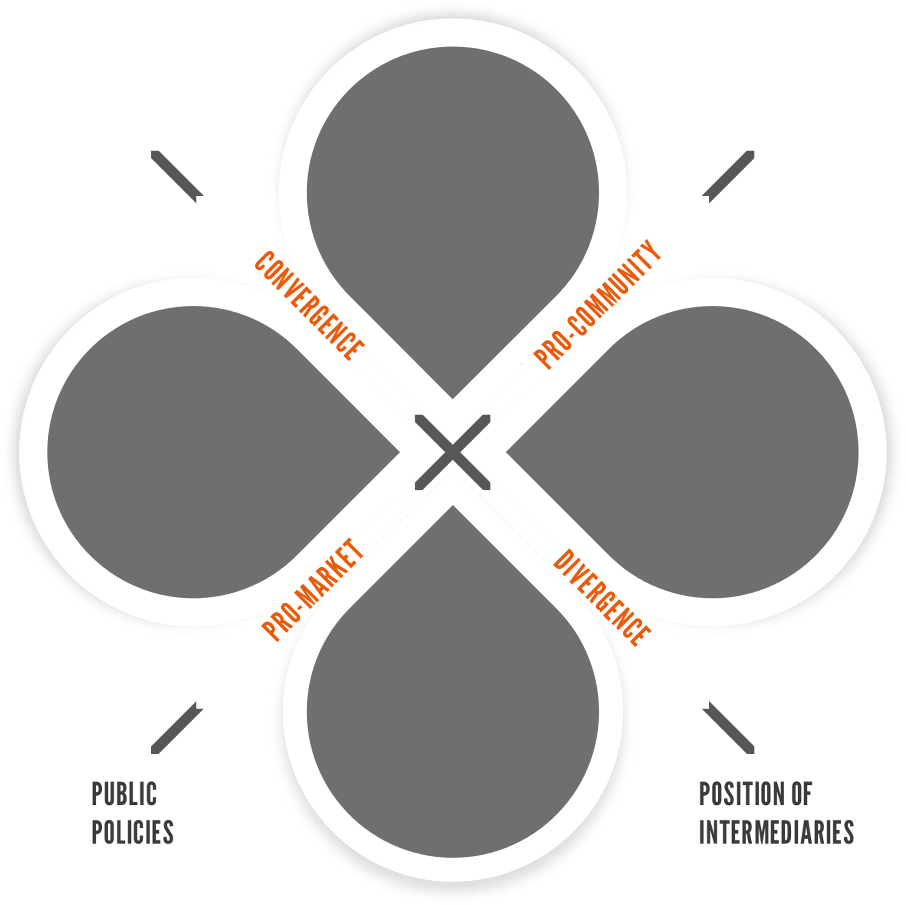Working with experts over future scenarios for culture we started from identifying two factors we believe will shape the way culture will be created, shared, and used in 25 years in Europe. We concluded that for the circulation of culture it would be crucial what direction the political power and the economic power would take. This way we received two pivots, outlining four potential “worlds” (see graph below).

The first pivot is political power shaped by public policies that are decided on by both domestic and European politicians and officials. They disburse funds through various institutions, among other things, ministries, institutes of culture, competitions, grants, scholarships. They also create laws that regulate culture circulation, for instance copyright1.
Public policies relating to culture may be founded on the belief that culture is a unique sphere, constructing social ties, supporting tradition, but also responding creatively to new challenges of reality. Thus it is worth supporting and protecting against mere profit and loss account, for example, through subsidizing creative work with a large amount of public funds. Such cultural policy we called “pro-community”.
But the cultural sphere may also be treated as a modern sector of the economy, with a very favorable rate of return (because it does not require large expenditures for materials and production technology), which must be verified up to the liberated market. We called such way of shaping public cultural policy “pro-market”.
The economic power that will shape future culture circulation consists of mass market intermediaries in the circulation of other people’s work, i.e. distributors of cultural works – or rather “content providers”. That is why we called the second pivot “position of intermediaries”. It seems that the crucial technology for future culture distribution will be the Internet. Thus looking at market relationships we outlined two possible tendencies: convergence and divergence.
Internet, similarly to other communication networks, is subject to the so-called network effect, with large hubs, attracting new users precisely because they are large (they have a lot of content, or - in the case of social networks - there are a lot of our friends there), each new user increasing the attractiveness to other potential users. This model of services and capital accumulation usually leads to the formation of oligopolies. Intermediaries in the culture circulation also aspire to the convergence of their services, which means the concentration within a single ownership structure of the various ‚stages’ of the circulation of culture, as well as products and services targeted to different audiences. In the case of the Internet circulation of content in Europe it is primarily Google (which owns YouTube and Google Books) and Amazon, and, perhaps less obviously, Facebook.
But we can also imagine another scenario in which tendency toward convergence would not be replaced by divergence. In the internet the opposite of centralized distribution are peer-2-peer networks, allowing their users to connect directly with each other and share resources accumulated on their own computers/servers (in such model works for example The Pirate Bay). Their popularity as providers of content continues unabated even though they are illegal. A divergence seems to be possible if each user would be able to use legally peer-2-peer, the formation of oligopolies was prevented by the antitrust policy of the state, taking care of the actual balance of the market and the establishment of protocols to handle communication among tools of different service providers (e.g. today one can call subscribers of another mobile network but there is no connection between the user of Facebook and gmail chat).
The circulation of culture is not just a matter of personal access to content (or lack thereof). It affects different spheres of social life, among other things, the level of empowerment of citizens, dominant discourse pattern defining a successful life, state of culture, art, education and the creative sector. Therefore, in each of the four scenarios for the future we tried to describe how each of these spheres would look like and how will be look like copyright, the law that regulates the culture circulation.
We tried to determine what the position of the three ‚players’ in the field of culture - authors, users and intermediaries - would be. This position is defined by legal categories such as: the duration of property copyright, scope of moral rights of an author, permitted personal use (fair use), educational and “artistic” exceptions, enforcement of violations of the law, role of collective management organizations. We also pondered over the issue of social security for artists, not recognized in the copyright acts.
We have made an assumption ordering our work on different scenarios that these two factors - the public policies and the level of convergence of intermediaries - would determine the scope of the copyright law operation. But one could reverse the logic adopted for study and recognize that it is the copyright law that has provoked the specific (in)balance of power in the cultural field. Then the scenarios could be read as models describing the effects of the proposed regulation. We hope that interactive webpage scenarios.prawokultury.pl would make it easier. The aim of the study is not to predict the future. It is rather an invitation to reflect on what it could be. We would like to encourage each of us to think which scenario is consistent with her or his idea of a successful life and proper social relations, i.e. what world we would like for ourselves and for others.
1: In Europe there function two systems of copyright law, which results from two different legal traditions – continental (copyright law) and Anglo-Saxon (copyright). The latter influences greatly the global circulation of content in the Internet, the biggest intermediaries being American firms, acting within the framework of their domestic law. International law contains elements of both systems – read more on page 38. Working on the future scenarios we did not try to foresee particular regulations but rather the scope and philosophy of authorship law/copyright, regardless of differences in legal constructions.
